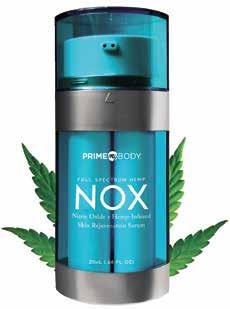
4 minute read
HEMP GETS HOT
HEMP GETS HOT Meet the Hardest Working Plant on the Planet
by Julie Peterson A crop that was illegal in U.S. soil for more than half a century is now reaching for the sun. Industrial hemp, the low- or no-THC cousin to marijuana, has created high hopes among farmers, agricultural researchers, manufacturers and consumers. By 2019, America had become the world’s third-largest producer, behind Canada and China, where it’s been cultivated for 8,500 years.
Advertisement
“It’s the fastest-growing ag industry that we’ve ever seen,” says Tara Valentine, hemp specialist at the Rodale Institute, in Kutztown, Pennsylvania. Since hemp’s inclusion in the 2018 Farm Bill, Rodale’s hemp web page hits have grown 10-fold. Better Products All parts of the hemp plant are useful in multiple ways, and hemp has applications in textiles, construction, bioremediation, technology, nutrition and health, including cannabidiol (CBD). The seeds are rich in protein, essential fatty acids and vitamins. They can be eaten, ground into flour or pressed for oil that is used for cooking or in body care products. The stems undergo decortication to separate the long outer fibers (bast) from the short inner fibers (hurd). Hemp hurd makes extremely durable hempcrete for construction, absorbent and dust-free animal bedding or pellets for heating stoves. An exponential rise in the use of hemp is expected because it can replace products made from paper, wood, plastic, cotton and fossil fuels.
“Hemp fiber is going to dominate the market once we get to the full manufacturing potential,” says Erica Stark, executive director of the National Hemp Association, in Washington, D.C.
The first introductions consumers can expect include hemp paper products, such as plates and toilet paper, and biodegradable hemp bioplastics like cutlery and cups. Construction materials and other products are expected to quickly follow. Environmentally Friendly The Institute of Papermaking and Printing, at the Technical University of Lodz, Poland, did a 2015 study comparing making paper Right now, it’s the Wild West of agriculture. ~Dustin Enge
from wood to making it from hemp. Among the findings: hemp takes four months to grow, while trees need 20 to 80 years. An acre of hemp can produce four or more times as much paper as an acre of trees. Hemp paper doesn’t need toxic bleaching and can be recycled twice as many times. Other studies concur.
Paper without deforestation would be a major benefit, but it’s a minor job on hemp’s profound résumé. “Hemp needs to be a part of every climate change conversation, not only because it sequesters huge amounts of carbon during cultivation, but also because construction products made out of hemp will continue to sequester carbon for up to 100 years,” says Stark. Hemp could also help save the depleted soil on U.S. farmland that has been destroyed by tilling and synthetic fertilizers. “We have to rebuild the soil by putting carbon back in and increasing organic matter,” says Valentine. Hemp does this with a massive root biomass that breaks up compacted soils, improves water infiltration and reduces runoff and erosion. Fast-growing hemp naturally suppresses weeds, needs no pesticides and isn’t picky about soil, water or latitude. By comparison, cotton is water-intensive and uses 25 percent of the world’s pesticides.
Income for Farmers Used in crop rotation, hemp’s soil-enhancing qualities can increase profits on subsequent crops. While cover crops don’t usually have return value, hemp provides additional revenue streams. But the revenue isn’t quite there yet, because the supply chain isn’t complete. Seed supply, farm equipment, education, processing facilities and manufacturers are all links that are developing simultaneously. “Fiber processing facilities will be available soon. Manufacturers are anxious to start incorporating hemp,” says Stark. The lack of buyers isn’t deterring farmers. Neither are warnings that current harvesting equipment can spark disaster when hemp fiber wraps around rotating parts, heats up and combusts.
Dustin Enge, a third-generation farmer in Prairie du Sac, Wisconsin, started
Honey Creek Hemp in 2017. He planted six acres of hemp. “I think it’s a long-term viable commodity for farmers. Right now, it’s the Wild West of agriculture. Everyone is trying different things,” says Enge, who modified a harvester for hemp. “I spent about two hours harvesting and 20 hours torching the fiber off my equipment.” Even so, he will plant more acres when he knows it will sell.
Behold the sprouting of the hemp industry as an ancient plant takes root in the modern world.
Julie Peterson writes from rural Wisconsin and can be reached at JuliePeterson2222@ gmail.com. The World’s Only Nitric Oxide + HEMP INFUSED SKIN REJUVENATION SERUM The fusion of nitric oxide & full spectrum hemp synergistically work with your cellular chemistry to revive skin complexion, minimize fine lines and wrinkles, and restore a youthful appearance. Some see results after the first use, while others may see more noticeable results after a few days.
Say goodbye to invasive spa treatments and hello to NOX!


2 WEEKS OF USING NOX
Calendars Find an Event in our

Visit NAChicago.com Does Your CBD/Hemp Oil Contain CBG? Sonicated Liposomal Technology Means...Fast acting (within seconds) long lasting plus added CBG and natural occuring terpenes. Nothing compares..
Available in two formulas FOCUS- Energizing CALM- Relaxing CBG amplifies the benefits of CBD PLUS • Anti-bacterial properties • Neuro-regeneration/protection • Bone health support • Mood & gut health support • Sleep Support • Natural analgesic (discomfort relief) Recommended by Healthcare Professionals
Please call or text with questions or to request a sample 630.309.3409 Attend a FREE educational presentation visit LetsTalkHempOil.com for locations and times.










